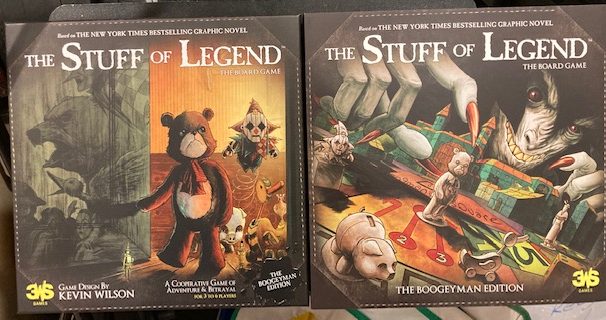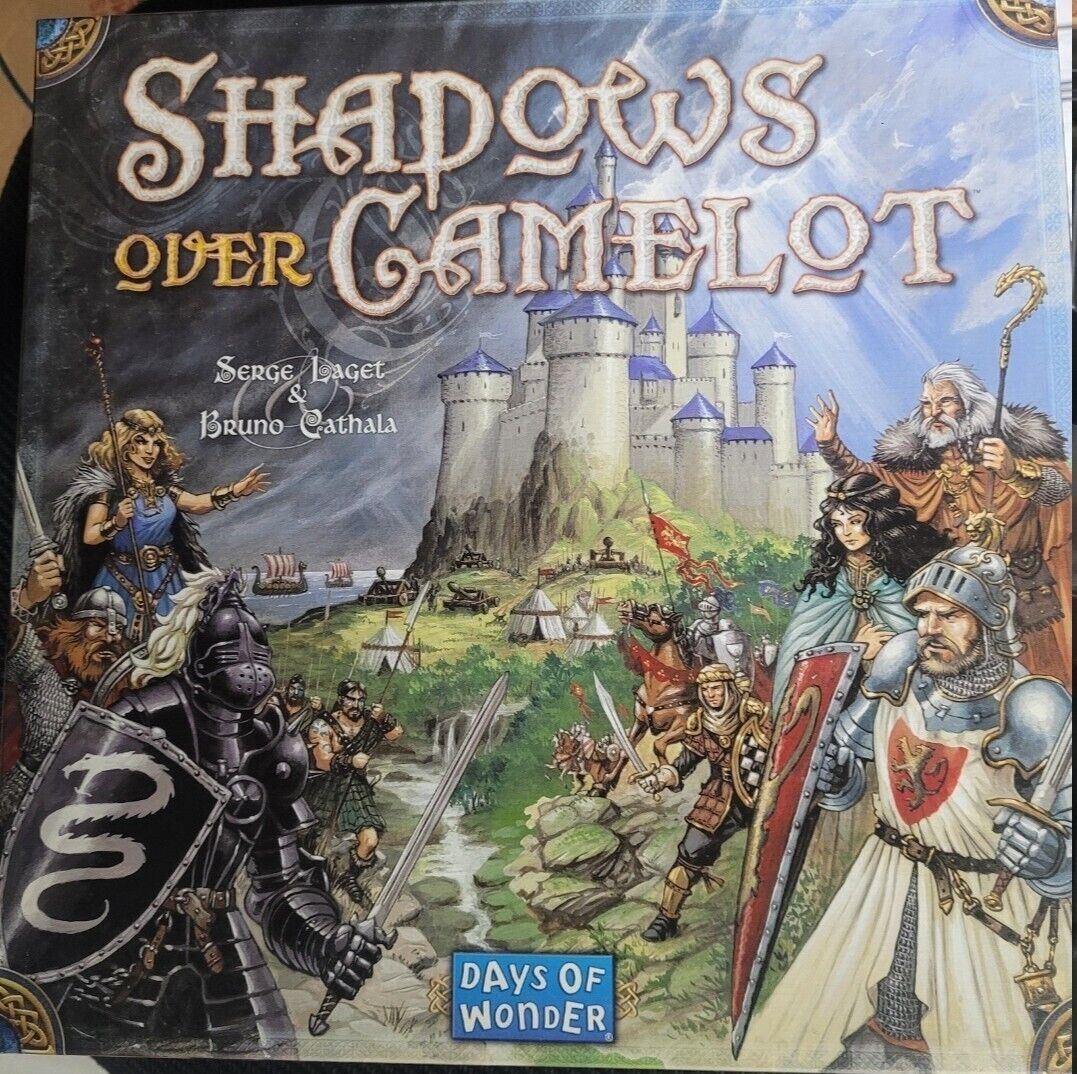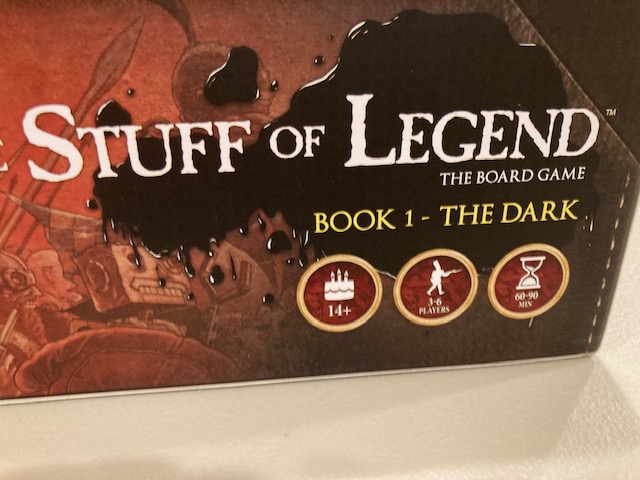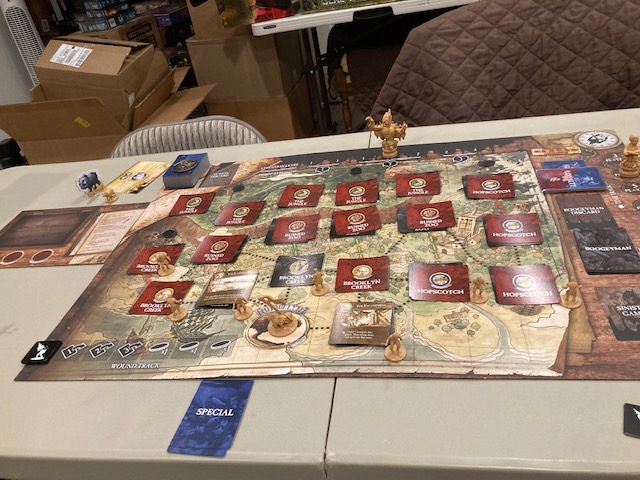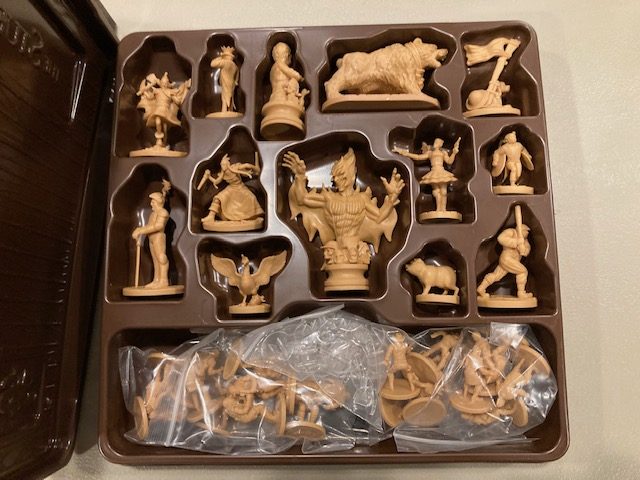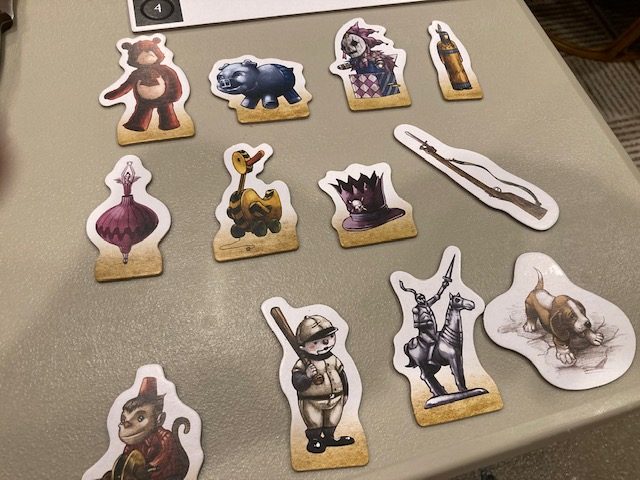
What’s a tile? Does a tile have to be a thick square piece of plastic? How about a thick piece of cardboard? How thick does a piece of cardboard have to be in order to classify as a tile? Can just a playing card be a tile? Our answer: A piece is a tile if it’s used like a tile in a tile-placement game. Although this definition sounds specious, it represents the reality that there are a lot of tile-laying or tile-placement games that use cards as tiles rather than piece of thick plastic/cardboard. It’s a tile if it’s used as tile and its placement matters! Below is our top 10 list of cooperative tile-placement or tile-laying games.
Now, there are some cooperative games that have tile-placement in them as a minor mechanic (such as Robinson Crusoe), but to be on this list, the game has to have tile-placement as a main mechanism in the game.
A Thought Experiment: Mechanical Beast

At first, it looks like Mechanical Beast might be a pure tile-placement game, but as you play/explore, you realize you get no choices when placing tiles! You have to place the top tile on the space you explored, without even the option of rotating the way you want! (You have to place the tile along the arrow).

What makes this an interesting spin on tile-placement is that, even though you have no choice on tiles when they come out, you can later rotate one or many tiles using the gear mechanism! This gives you some choice in the topology of your tile grid. Mechanical Beast is weird, and while not strictly speaking a tile-placement game, it kinda looks-and-feels like a tile-placement game once you get into it. Strictly speaking though, you have no choice when you place a tile: its orientation and placement is set, and so we don’t consider this a tile placement/tile laying game. (Arguably, you have choice as which room you build from, so you can influence topology, but it’s not quite enough choice).
The main point of this discussion of Mechanical Beast: for all of The Top 10 Cooperative Tile Placement Games, players have some choices when they place a tile (orientation, placement, side, topology, etc) and those choices makes a difference in the game. Some games will, of course, have more choice than others: in general, the higher a game is on this list, the more choice you have in your tile placement!
10. Chainsomnia
Solo Game: Yes (but must play 3 characters)
Players: 1-4
Time: 40-60 Minutes
Tiles: square medium-thick cardboard
Chainsomnia is #10 on this list because there’s probably the least choice in tile placement: when you explore, you must place a tile legally connected to the room you are in, but you do get choice in orientation which entrances connect (as well as the topology, as you control which room you explore from).

As you play, you have get all tiles out to expose the exit: players only win if at least one player makes it to the exit and all nightmares are discarded!

This is a cute and lighter cooperative tile-placement game, where the topology does matter because you have to make sure to keep a way to the exit open as you explore, but still manage to keep the nightmares under control!
9. Cities: Skyline
Solo Game: Yes
Players: 1-4
Time: 40-70 Minutes
Tiles: polyomino cardboard tiles, medium thickness
Cities: Skylines is based on a video game. In this board game adaptation, players cooperatively execute urban planning for a city (this is a city-building game after all).

What makes this is a little different than other tile placement games on this list is the tiles do have slightly different shapes! We did not necessarily specify that the tiles all had to be the same shape, and in this case they are not! (Unfortunately, at the time of this writing, there probably are NOT that many cooperative polyomino games!)

This is a fun, but more complicated tile placement game where tile placement absolutely matters!
8. Forgotten Depths

Solo Game: Yes (you can play from 1 to 3 characters)
Players: 1-3
Time: 60 Minutes
Tiles: square cards
Forgotten Depths is a dungeon crawler game where the tiles come out as you explore the dungeon. This is still a dungeon-crawling adventure game, but the tile placement is a main mechanic that influences the shape of your adventure. When you draw and place tiles (Map Tiles), there are a few rules you have to follow (“All edges of the new Map Tile must match the edges of all the tiles they’ll touch”), but in general you have some choices as you place tiles. You’ll want to try to create Legendary Locations to provide XP and cool story elements, you’ll want to put the campfire close enough, you’ll want to make sure monsters, doors, chests, are close enough/far away.
You have three different “ecologies” you play through, so there’s quite a bit of variety.

The choices you make when placing the tiles in your dungeon have an effect on how your game unfolds. It’s pretty fun: the tile-placement is more about how you want your adventure to run than “scoring points”, but it’s a main and important mechanism in the game.
7. Sub Terra/Sub Terra II

Solo Game: Yes (but must play 3 characters)
Players: 1-6
Time: 60-75 Minutes
Tiles: square medium-thick cardboard
Sub Terra and Sub Terra II are lower on the list … not because they aren’t great games, but because the amount of choice in tile-placement is less pronounced. Certain powers allow the players some choice in choosing tiles that come out (The Scout in Sub Terra or The Archaeologist, The Aristocrat, or The Foreman in Sub Terra II), players can also have some choice in orientation of tiles (as long it’s legal) that come out, and basic actions allow the players to reveal a tile before moving on them, but the amount of tile choice is a little more limited: generally, most players take the top tile and place it where they are going.

Having said that, both of these still feels like tile-placement games, as you play tiles in the play area! Sub Terra II definitely feels more like tile-placement, because the shape of your exploration (where you explore) helps influence where the final Artifact shows up! Both of these are great cooperative games: I would give the nod to Sub Terra II as it has a little more true tile-placement, but Sub Terra is still a great game and has that tile-placement feel. Take a look at our review here of Sub Terra II to see if it’s something you might enjoy!
6. Escape: Curse of the Temple

Solo Game: yes
Players: 1-5
Time: “realtime” (really, that’s what the box says)
Tiles: larger, heavy thickness tiles
Escape: The Curse of the Temple is probably the odd duck on this list: it’s a real-time dice-chucking cooperative game about exploring a temple as fast as you can! Your tile-placement choices seem less consequential, but they are absolutely vital! You need to explore quickly, placing tiles! You can only place tiles (“discover a chamber”) from your current tile, but you can choose how it connects via orientation.

All this exploration is happening in real-time, so the dungeon is being explored by everyone as they play. You need to be talking as you explore and keep some players under control: “Don’t explore too far that way or you’ll make it too hard to get to you if you get trapped!!”

The topology matters in this game! If you explore too far along a long corridor, you may isolate yourself or the exit from the rest of the team! So, where you explore (as you are crazily rolling dice) really does matter. So, it may seem like a quirky choice, but the tile-placement choices (the speed of choice, the collaboration of choice, the choice of orientation of the tile) do matter in this game. And it’s really fun!
5. Dead Men Tell No Tales
Solo Game: no
Players: 2-5
Time: 60-75 Minutes
Tiles: medium sized, medium thickness tiles
Dead Men Tell No Tales is a favorite in my game groups: I got two copies when the original Kickstarter went up, giving one away as a birthday present. Players each take the role of a pirate (with special abilities), and players work together to loot a pirate ship before it explodes! It’s not real-time (although it sounds like it might be)!

There’s a lot going on here, but the tile placement is essential to the game: every turn, one player must draw a tile and place it legally somewhere on the pirate ship that’s exploding! Not only does the topology matter, but things like where treasure, monsters, and Fire Dice placed also matter!

Where and how you place the tile on the soon-to-be-exploding pirate ship matters a great deal! This doesn’t, at first, look like a tile-placement game, but it absolutely is.
4. Castellion

Solo Game: yes
Players: 1-2 (although it’s easy to have 3 or 4 people playing cooperatively as a unit)
Time: 60 Minutes
Tiles: smaller, medium thickness tiles
Castellion is a game in the Oniverse line of games, and it is all about laying tiles! Players have to place tiles on a board with shapes and colors on the tiles affecting how tiles can and can’t be placed.

There are some really interesting decisions when you place your tiles. We ended up expanding the player count to 3 easily: we all just work together make the decisions as a single player would and deciding how to play the tiles.

This is a pure tile-laying that was challenging and fun! The typical arc of our gameplays would be to lose the game but then want to play immediately to try again! It is quite fun and challenging!

3. Tranquility

Solo Game: Yes (slight variation, main game is cooperative with multiple players)
Players: 1-5
Time: 20 Minutes
Tiles: square cards
The joke is that Tranquility is not tranquil at at! It’s all about placing cards in a 6×6 grid so that the numbers are strictly increasing .. and it can be very stressful how/when to place your cards! The cards are numbered from 1-80, and when you place a cards, you have to place it such that it is in increasing order … but if you place next to another card, you must discard cards of the difference between the two numbers.

If you ever run out of cards or can’t play a card in order, you lose! This is also a hidden information game: you are not allowed to talk to your fellow players as you play.

This is a surprisingly fun small game, with lots of interesting decisions about where to place cards. Although there’s no real theme here (it’s just a tile/card placement game), the sailing ship and cute art really enhances the game.

2. Sprawlopolis/Agropolis/Naturopolis

Solo Game: Yes (generally, this is regarded as a solo game, with cooperative rules tacked-on)
Players: 1-5
Time: 35 Minutes
Tiles: poker-sized playing cards … just plain cards
We love all three of these tiny 18-card button shy games! Each one has a slightly different theme (build a city in Sprawlopolis, build in a rural environment with Agropolis, or a natural environment in Naturopolis), but they all work essentially the same way!

Players choose 3 of the 18 cards as scoring conditions (see above), then players use the rest o the 15 cards to score the best they can! One of the reasons this game is so high on our list is how much agency you get in the game for laying your tiles! Players get 3 cards per turn, choose one, and can place it anywhere on the board (over cards, next to, above, with a few restrictions) with one of two orientations! The amount of choices and agency is why it is also so high on our Top 10 “Small” Cooperative Games list! See also our review of Agropolis here.

1. Mists Over Carcassonne

Solo Game: Yes (easy to do: just take 3 meeples in each of 4 different colors and play normally)
Players: 1-5
Time: 35 Minutes
Tiles: square light-thick cardboard
Mists Over Carcassonne is the tile-laying game that inspired this list! Each tile, when lain, has so many juicy decisions: Do I try to set-up scoring opportunities for my fellow players? Do I mitigate ghosts? Do I score? Can I do many of these things at once? It’s also so interesting how the tile itself is both the good news and bad news!

The solo game is a wonderful little 35 minute puzzle, with 6 levels of difficulty to keep the player engaged. The cooperative game seems to inspire so many discussions! Even the Alpha Player is kept at bay, at least a little, as each player owns the tile he/she places. Mists Over Carcassonne is a fantastic, easy-to-teach, quick-to-set-up, simple but deep game that works great as a solo game and a cooperative game (and a competitive expansion for the base game to boot)! Mists Over Carcassonne was also a nominee for the best cooperative game in the 17th Annual Golden Geek Awards!

































































































































































